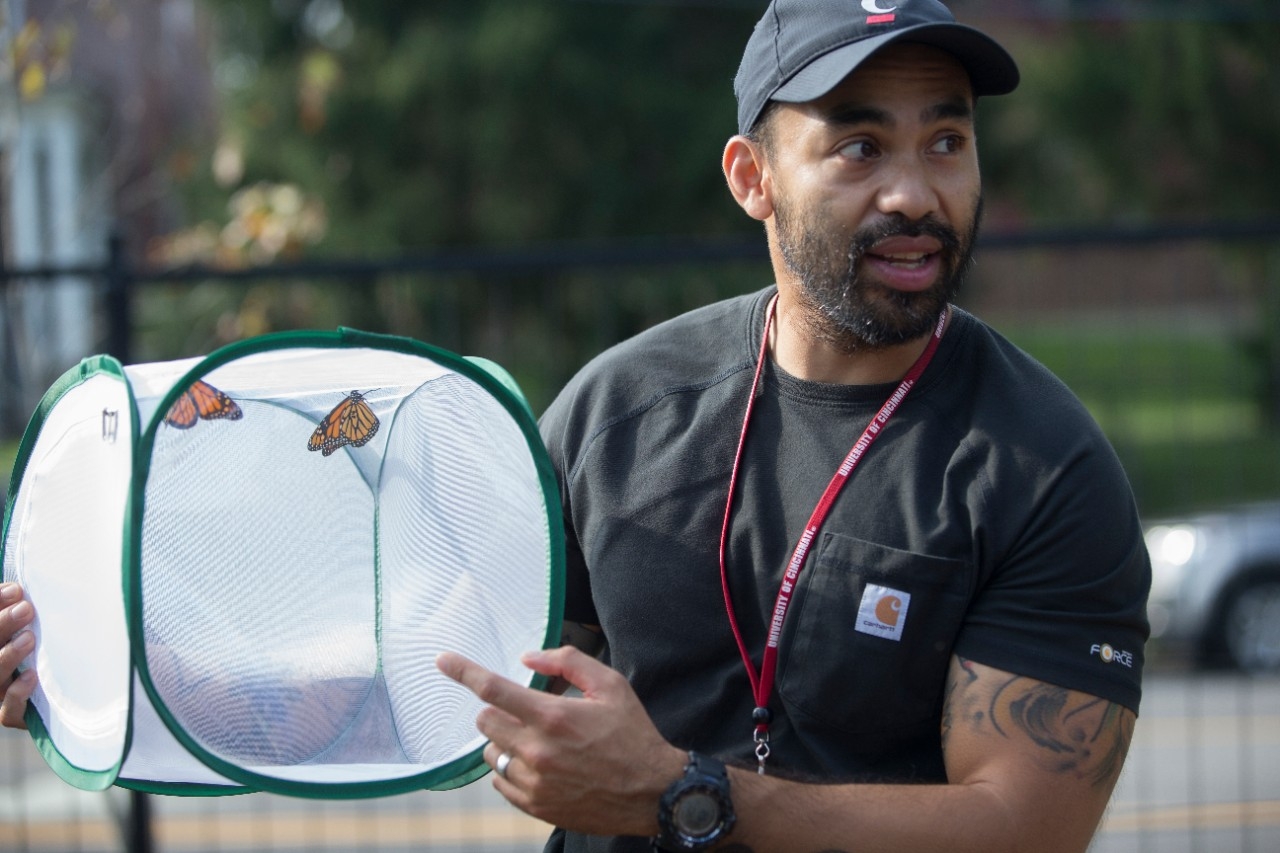UC biology professor Patrick Guerra holds a carrier full of monarch butterflies. He is studying the epic, multi-generational migration of these colorful butterflies.
Latest Magazine
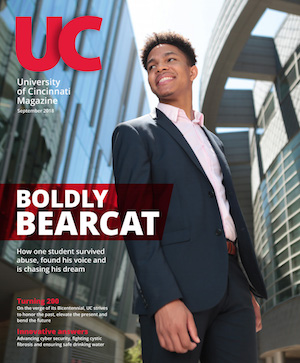 September 2018
September 2018
Boldly Bearcat
Finding his voice
Danger in the tap
Virtual defense
Global game changer
Celebrating UC's Bicentennial
 Past Issues
Past Issues
Browse our archive of UC Magazine past issues.
Kings of navigation
UC biologists are unravelling the mystery behind the monarch butterfly’s epic 3,000-mile migration.
By Michael Miller
513-556-6757
Photos by Lisa Ventre/UC Creative Services
Oct. 3, 2017
Monarch butterflies flutter to the same mountains in Mexico each winter even though neither they nor their parents or grandparents have ever been there.
Now a University of Cincinnati biology professor is trying to unravel the mystery of the monarch’s multigenerational migration at UC’s Center for Field Studies.
“What’s amazing about monarchs is they go to the same general area in Mexico year after year, but they’ve never been there before. It’s their great-grandparents who were last there,” said Patrick Guerra, assistant professor of biological sciences at UC's McMicken College of Arts & Sciences.
Many creatures undergo epic migrations. Wildebeest travel 900 miles from the African Serengeti to the Maasai Mara and back in search of fresh pasture every year. Sea turtles return to the beaches where they hatched to lay their own eggs. And some shorebirds fly from the tip of South America to the high arctic and back every year in a 9,000-mile odyssey.
But Guerra said monarchs are special because their round-trip migration from the United States and southern Canada to central Mexico requires several generations to complete.
“The butterflies have never been there before. Their sense of direction has to be hardwired,” he said.
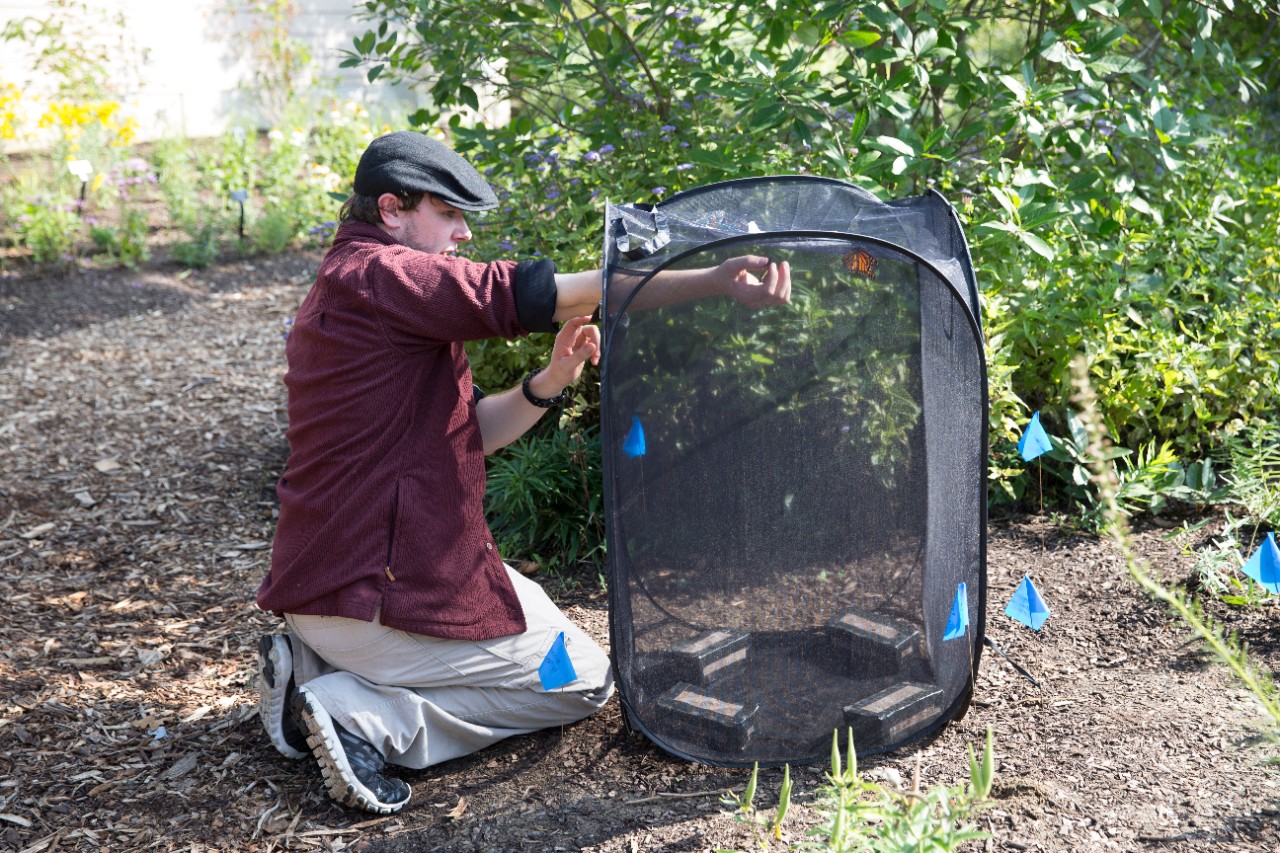
UC biology student Jered Nathan removes a butterfly from the enclosure at the Cincinnati Zoo & Botanical Garden.
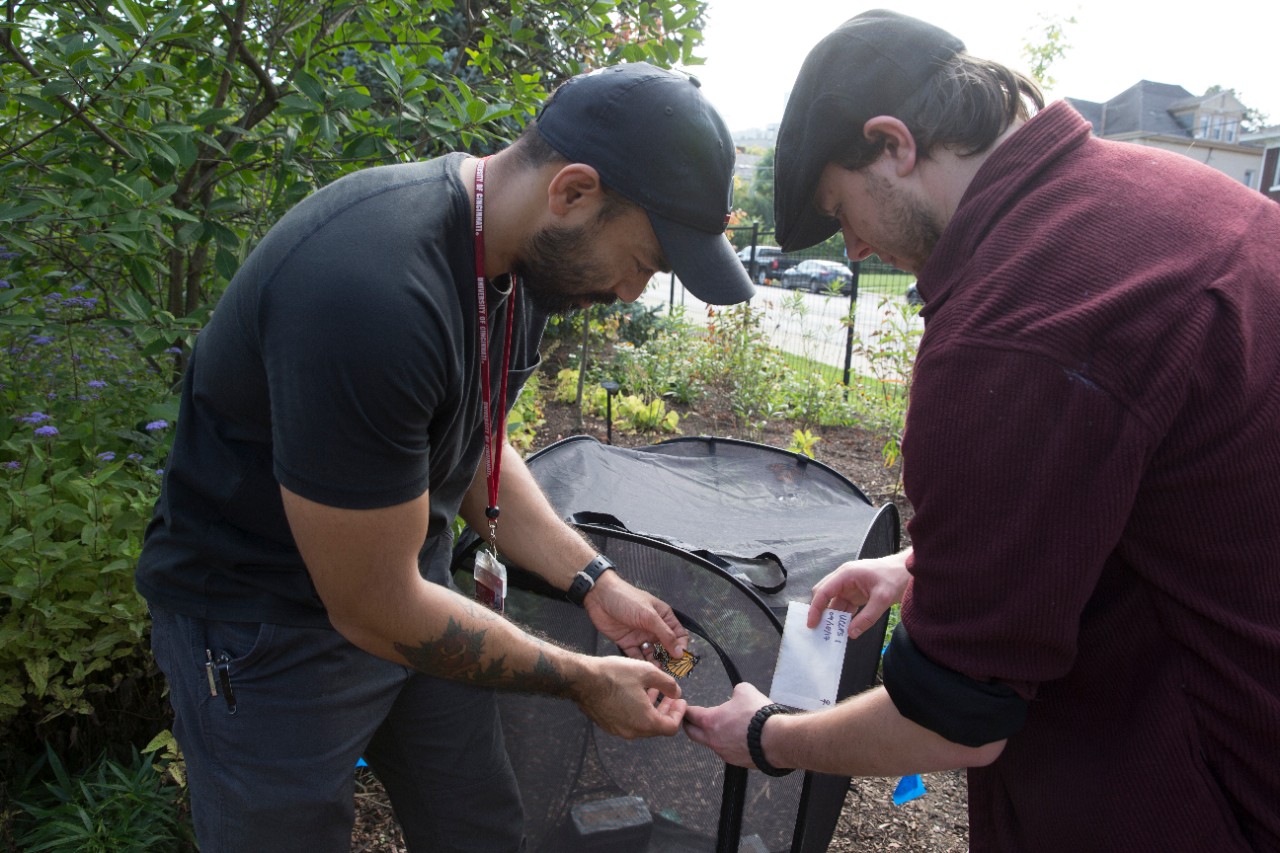
UC biology professor Patrick Guerra and student Jered Nathan examine a butterfly in their migration study.
Scientists know that monarchs navigate by the position of the sun in the sky — like an internal sundial. It’s the same way that ants and bees orient themselves.
“We know they use the sun and the Earth’s magnetic field as guides. But we don’t know how they know when to stop,” Guerra said.
The mountains west of Mexico City are the perfect place for monarchs to spend the winter, he said.
“They’ll roost in groups at these overwintering sites. It’s the perfect temperature,” Guerra said. “It’s neither too cold that they freeze to death nor too warm that their reproductive drive kicks in. When it gets hot, they turn to reproductive mode. So they’re trying not to be in that reproductive status to conserve their metabolic reserves.”
“I’m trying to understand how their brains work. What’s amazing is they have a brain the size of a pinhead, and they’re doing something that would take us all sorts of complex computations to do.”
‒ Patrick Guerra, UC assistant professor of biological sciences
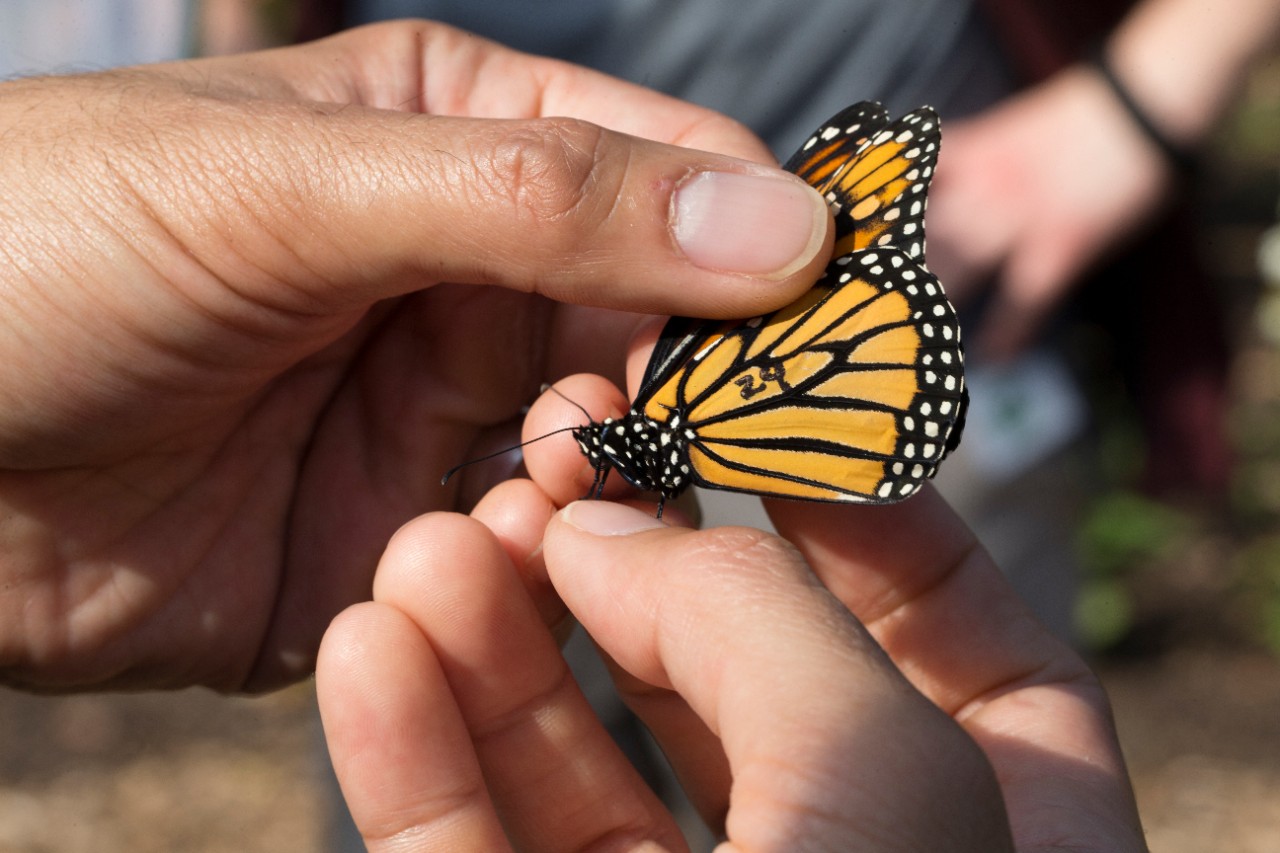
Each butterfly in the study has a unique identification number.
The butterflies cluster together on the pine and oyamel fir trees for warmth. Scientists estimated there were as many as 1 billion butterflies gathered in the mountains in 1996. That number has dropped precipitously since then. Last year, conservation groups estimated that 145 million butterflies roosted in the reserve, roughly an 85 percent decrease.
Scientists are trying to understand what’s behind the sharp decline. Possible culprits include ubiquitous pesticides used in agriculture and landscaping in North America and deforestation within the Mexican reserve. Some backyard gardeners plant nonnative milkweed that stays in flower longer in the fall, which could prompt some monarchs to linger in the north. A sudden cold snap could kill them.
“Its conservation status is either threatened or ‘species of concern,’ depending on whom you ask,” Guerra said.
Today, western butterfly populations are most at risk. Conservation groups across North America are working to restore prairie habitat from Nova Scotia to California.
Not all monarchs migrate. Populations in Florida remain in the Sunshine State year-round. But climate change is likely to affect a species that traverses an entire continent depending on the season, Guerra said.
“As the climate gets warmer, they might not have to migrate as far. If it’s warm enough, they could just stay in Texas for the winter,” he said. “These are all unanswered questions.”

A monarch butterfly.
“We have pollinator-friendly plants everywhere. ... You don’t need a big botanical garden. Anyone can do it.”
‒ Lyn Lutz, exhibit manager at the Cincinnati Zoo & Botanical Garden
Guerra studied a variety of insects prior to taking on butterflies. He has been studying monarchs for more than five years.
“I was interested in dispersal, how insects disperse from certain areas and what they’re looking for,” he said. “But migration always interested me. This movement is more directed — they’re going to a place and back.”
Guerra and his students are trying to determine what effect, if any, increasing urbanization has on the butterfly’s circadian rhythms and knack for navigation.
Students Alexis Moore and Jered Nathan captured monarchs at UC’s Center for Field Studies next to Miami Whitewater Forest in southwest Ohio. Butterflies were placed in mesh enclosures at nine places around the Tristate: three rural, three suburban and three urban. There the butterflies are subjected to the ambient light and noise of city life or the darkness and tranquility of rural living.
One site is a flower garden a few blocks from UC at the Cincinnati Zoo & Botanical Garden. Guerra’s students keep the monarchs in a three-foot-tall mesh box on a mulch bed next to the landscaping. Despite the busy city traffic just beyond the zoo security fence, monarchs and other butterflies flitted from flower to flower around the garden.
“Volunteers have adopted this garden. We have pollinator-friendly plants everywhere,” said Lyn Lutz, an exhibit manager at the zoo.
The zoo has exhibits on native plants throughout its 69 acres to encourage and inspire people to plant their own butterfly gardens, she said.
“Everyone should do their part,” she said. “You don’t need a big botanical garden. Anyone can do it.”

UC biology professor Patrick Guerra, right, explains his migration study to Lyn Lutz, an exhibit manager at the Cincinnati Zoo & Botanical Garden. The study has nine sites around Cincinnati.
On a daily visit, students carefully removed a monarch from the enclosure. Each butterfly has its own identification number written in marker on a wing.
“We name them when he’s not looking,” Moore joked of her professor.
The students feed their test subjects a honey solution each day while the butterflies get used to their new surroundings.
After a few weeks, the monarchs will be released on a still afternoon at the UC field station to see how they orient themselves and whether researchers can discern any difference in flight trajectory among the city, suburban or urban groups, Guerra said.
“At this time of year, fall monarchs should always have the drive to fly south,” he said. “But if you live in the city, if your circadian clock is so disrupted that you can’t use [it] to keep track of the time of day, you might use the sun incorrectly. That’s our hypothesis. We’re predicting urbanization or its effects might affect their behavior.”
Light pollution interferes with wildlife in lots of ways. Turtle hatchlings on coastal beaches can mistake streetlights for the moon and scurry into traffic. Bright lights have been known to disorient migrating birds so badly that they fly into buildings.
And when navigating such great distances, a couple degrees of navigation error could send the monarchs hundreds of miles off course.
If the study determines that city monarchs are prone to disorientation, the next step will be to determine what it is about outdoor lights that disrupts their uncanny navigation system.
“Is it the intensity of the light or is it LED versus incandescent or fluorescents?” Guerra said. “It could be that certain wavelengths of light matter. For example, a lot of moths and night insects use the moon to navigate at night.”
At the field station, researchers also harness butterflies and test them in a flight simulator, sort of a butterfly treadmill. Although flying in place, the butterflies can orient themselves 360 degrees. In flight-simulator trials, monarchs can be tested under various outdoor or indoor testing conditions, during which their flight behavior can be monitored and analyzed. The path of flight directionality they choose in the simulator trials helps researchers learn more about how butterflies orient themselves.
The undergraduate students are enthusiastic about doing fieldwork. Nathan, 22, of Medford, Oregon, said he plans to apply to graduate school at UC to continue his biology research.
“When I tell my family, particularly my dad, about the research — I’m working with butterflies — it’s easier to relate to than a chemical equation or a math formula,” Nathan said.

UC biomedical engineering student Alexis Moore holds up a monarch butterfly that is part of their migration study. “We name them when (the professor) is not looking,” she joked.
Student Moore, 21, of Columbus, Ohio, is studying biomedical engineering. Her specialty is biomimicry or how engineers and designers can take natural cues molded by evolution to design better products. For example, the air intakes of fighter plane engines are shaped like the nares (or nostrils) of peregrine falcons, which can breathe even when stooping on prey at 200 mph.
“These creatures have had hundreds of millions of years to evolve and find solutions to problems,” she said. “We can take those solutions and apply them to what we want to do.”
Growing up, Moore said her parents used to scold her never to touch a butterfly.
“They used to say butterflies had a special flying dust. If you touched them, they couldn’t fly anymore,” she said.
But in doing the research, she learned that monarchs are surprisingly hardy. Researchers gently handle them to move or feed them.
“The biggest surprise for me was just how big monarchs get. I’ve been dealing with the smaller summer monarchs in the lab,” Nathan said. “The migrating monarchs are much, much bigger.”
Guerra plans to conduct the monarch study over several years to validate their findings.
“I’m trying to understand how their brains work. What’s amazing is they have a brain the size of a pinhead, and they’re doing something that would take us all sorts of complex computations to do,” he said. “Monarchs are a cool model system.”
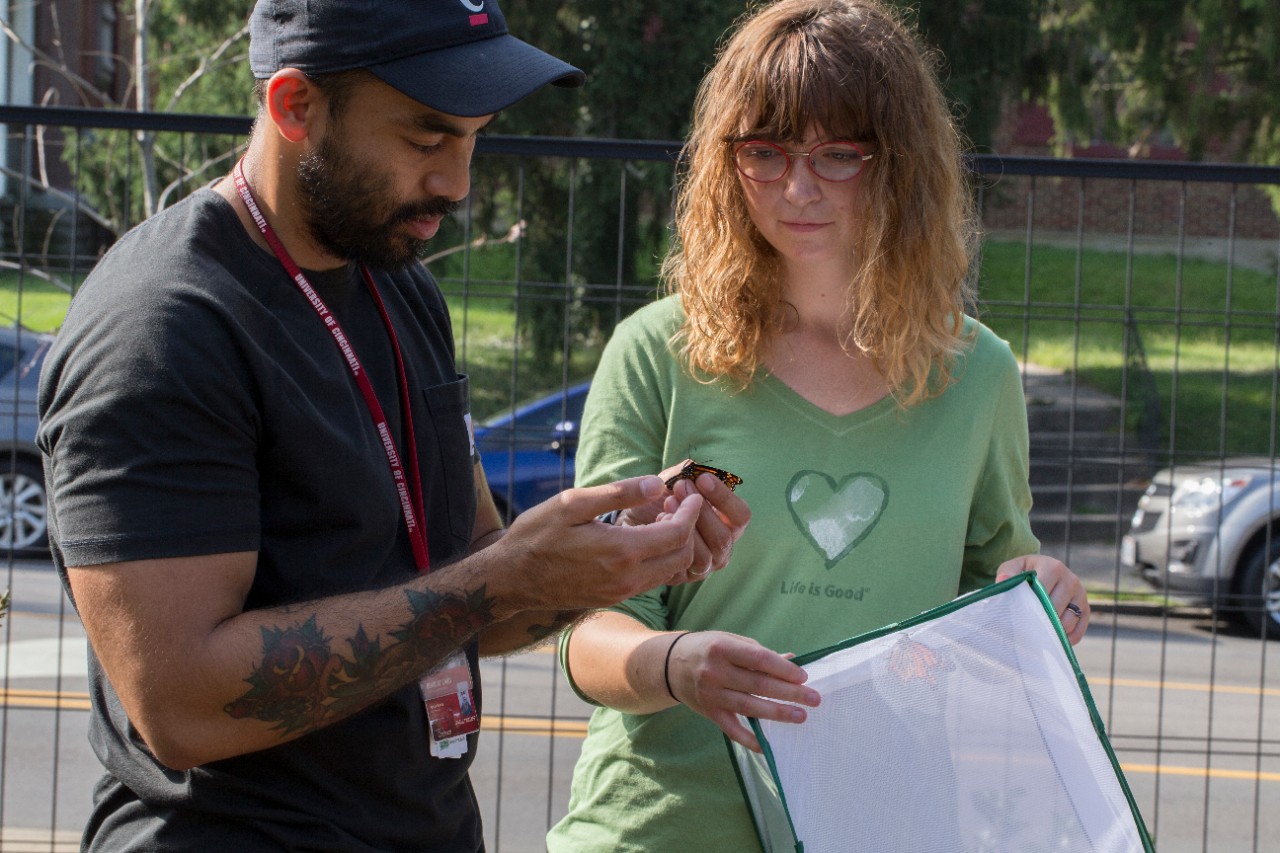
UC professor Patrick Guerra and student Alexis Moore examine a monarch specimen that is part of their migration study at sites such as the Cincinnati Zoo & Botanical Garden.
Field research to labwork
Do you like field research? At UC, biology students get hands-on experience in their chosen subject area. Check out the Department of Biological Sciences or explore other programs on the undergraduate or graduate level.

